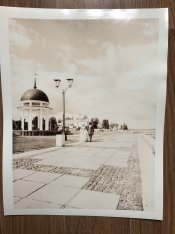iakustov
Member
I wanted to try Chemco lith developer with Fomatone and Slavich paper using the original formula, except for potassium formaldehyde bisulfite - I replaced it with sodium formaldehyde bisulfite:
Concentrate A:
Water 52 C - 500 ml
Hydroquinone - 135 g
Sodium formaldehyde bisulfite - 98 g
Diethylene glycol - 118 ml
EDTA - 0.26 g
KOH 45% - 2.8 ml
Water to make 1000 ml.
OK, in an hour I was able to completely dissolve 135 grams in 600- 700 ml of water at 52 C.
After pouring sodium formaldehyde bisulfite the solution became very dense and looked like a porridge or wallpaper glue, but after adding diethylene glycol it became transparent again. I added everything required and the final concentrate was really clear (I swear) with no residue, I poured it into two 500 ml bottles and started to prepare concentrate B.
After ~2 hours as I was preparing the working solution (1 A + 1 B + 4 Water) I noticed that concentrate A was full of those hydroquinone small "needles". I stirred it before adding into the working solution and started printing.
Now concentrate A (two 500ml bottles) looks like this:


What did I do wrong?
It looks like hydroquinone solubility in water depends on the temperature: 5 g in 100 ml at 5C, 20g at 50C, 56g at 70C. Could this be the reason so that after solution cooled down hydroquinone started to crystallise? Unfortunately, I have very limited chemistry knowledge.. But as there is no mention about this in the sources for the formula, I tend to think I did something wrong.
Maybe someone had experience with developers having highly concentrated hydroquinone?
As for my experiment - the prints came out fine, with more pronounced effect on Slavich. Development was in 6-8 mins range for both papers. Next time I will prepare the working solution straight away, avoiding the concentrates.
Concentrate A:
Water 52 C - 500 ml
Hydroquinone - 135 g
Sodium formaldehyde bisulfite - 98 g
Diethylene glycol - 118 ml
EDTA - 0.26 g
KOH 45% - 2.8 ml
Water to make 1000 ml.
OK, in an hour I was able to completely dissolve 135 grams in 600- 700 ml of water at 52 C.
After pouring sodium formaldehyde bisulfite the solution became very dense and looked like a porridge or wallpaper glue, but after adding diethylene glycol it became transparent again. I added everything required and the final concentrate was really clear (I swear) with no residue, I poured it into two 500 ml bottles and started to prepare concentrate B.
After ~2 hours as I was preparing the working solution (1 A + 1 B + 4 Water) I noticed that concentrate A was full of those hydroquinone small "needles". I stirred it before adding into the working solution and started printing.
Now concentrate A (two 500ml bottles) looks like this:


What did I do wrong?
It looks like hydroquinone solubility in water depends on the temperature: 5 g in 100 ml at 5C, 20g at 50C, 56g at 70C. Could this be the reason so that after solution cooled down hydroquinone started to crystallise? Unfortunately, I have very limited chemistry knowledge.. But as there is no mention about this in the sources for the formula, I tend to think I did something wrong.
Maybe someone had experience with developers having highly concentrated hydroquinone?
As for my experiment - the prints came out fine, with more pronounced effect on Slavich. Development was in 6-8 mins range for both papers. Next time I will prepare the working solution straight away, avoiding the concentrates.












